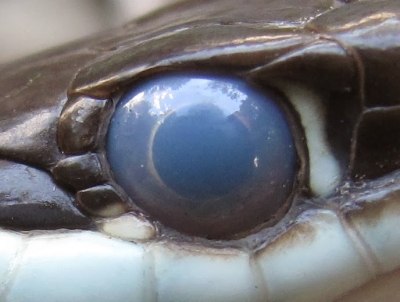
Unlike other animals’ eyelids, snakes’ spectacles are transparent, like a window in their skin, allowing them to see out through their always-closed eyelids. Just before a snake sheds its skin, a layer of fluid builds up between the new inner skin and the old outer layer, clouding the spectacle and causing the other scales to have a faded, milky appearance. This period usually lasts a few days, during which snakes have difficulty seeing and usually will not eat. People who keep snakes as pets have observed that they may become particularly ornery during this period, perhaps as a result of not being able to see clearly.
Frogs, lizards and snakes all use their third eyelids to protect their eyes from dust, mud and injury. Because they spend their lives so close to the ground, their eyes have developed nictitating membranes to clear away any debris that may cause irritation. Amphibians, such as frogs and salamanders, use their third eyelids as goggles when underwater; they draw them up to protect their eyes from the H2O and dive in. Their third eyelids not only protect their eyes but also allow them to see as clearly underwater as they do on land.
Another obstacle to snake vision that has been long known but little studied is that snakes’ spectacles are vascularized, meaning that they have blood vessels running through them. It is very unusual for tetrapods to have blood vessels in a place that might interrupt their field of vision. First noticed in 1852, these vessels are small but symmetrically distributed across the optically transmissive region of the eye in most species, although the arrangement is radial in basal snakes, acrochordids, and vipers but vertical in colubrids and elapids. In one visually-oriented species, the Asian vine snake (Ahaetulla nasuta), these blood vessels are less dense in the region of the field of vision known as the fovea, where the maximum sharpness is achieved. Most snakes don’t have foveas, suggesting that the unusual arrangement of blood vessels in the eyes of Ahaetulla is an adaptation to minimize visual disturbance in this region of highest visual acuity.
Picture Credit : Google




